Francis Fortune
Fortunes Rocks received its name from Francis Fortune, who, as a young man, was shipwrecked nearby and reached shore, barely alive. He had spent much of his youth as a sailor and an American privateer in the Revolution and was captured by the British in 1778. Because of his age-about 15-he was released without imprisonment. He was befriended by a 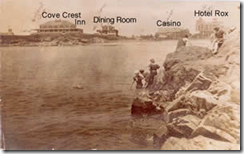 couple whose name was Rossiter. They took him into their home and he worked on their farm. Years later when Mr. Rossiter passed away, Fortune married his widow, Peggy, and the couple became well known to everyone in town as Uncle Fortune and Aunt Peggy. They had two sons who went to California during the gold rush of 1849. It was at this time that the Fortunes transferred all of their property along the beach to the city of Biddeford in exchange for their keep for the rest of their lives.
couple whose name was Rossiter. They took him into their home and he worked on their farm. Years later when Mr. Rossiter passed away, Fortune married his widow, Peggy, and the couple became well known to everyone in town as Uncle Fortune and Aunt Peggy. They had two sons who went to California during the gold rush of 1849. It was at this time that the Fortunes transferred all of their property along the beach to the city of Biddeford in exchange for their keep for the rest of their lives.
Both Francis and Peggy Fortune are buried in a field by a pond at the base of "the big rock" and their graves are marked by two slabs of dark marble. The elderly couple were quite popular in town and were the first to live in that area on a permanent basis.
The Story of Fortunes Rocks
As long ago as 1794 one William Hannon purchased land which had been previously owned
 for many years by Bachelor Hussey of the Pool, said land being now occupied by the colony at Fortunes Rocks and lying between the Etherington property and the small cove, near which are both the Casino and Hotel Rox. Right here is the beginning of a romance which gave to the Rocks its name and place on the map.
for many years by Bachelor Hussey of the Pool, said land being now occupied by the colony at Fortunes Rocks and lying between the Etherington property and the small cove, near which are both the Casino and Hotel Rox. Right here is the beginning of a romance which gave to the Rocks its name and place on the map.
After buying the land, William Harmon built a small house on the spot, where the well known Eaton house now stands, next to the large house belonging to Mrs. Hatch. It is said that the present small house was erected over the same cellar made by Harmon. William Harmon and his wife were the parents of a daughter, Peggy, whose fame as a rustic beauty lingered for many years. The Harmons sold butter, eggs and other products of their farm at the Pool store and often times Peggy either accompanied them or made the little trip by herself.
A sailing vessel, doubtless a small coaster, was wrecked nearby and the surviving sailors made their way to the Pool, where they shipped as occasion served on vessels putting in at that port. But one young seaman still lingered, Francis Fortune by name, for he had caught 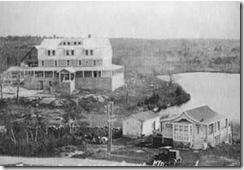 sight more than once of the pretty Peggy at the Pool store. Of course the girl was soon aware of his admiration-what maiden is not-and the romance grew apace: The trader and his wife were good friends to young Francis Fortune and did their best to encourage the love affair. Father and mother Harmon soon saw what was going on and did not regard the situation with favor, particularly Mrs. Harmon, who objected most seriously to a penniless sailor as a suitor for her daughter and said so very frankly.
sight more than once of the pretty Peggy at the Pool store. Of course the girl was soon aware of his admiration-what maiden is not-and the romance grew apace: The trader and his wife were good friends to young Francis Fortune and did their best to encourage the love affair. Father and mother Harmon soon saw what was going on and did not regard the situation with favor, particularly Mrs. Harmon, who objected most seriously to a penniless sailor as a suitor for her daughter and said so very frankly.
The storekeeper and his wife sympathized with the young couple and put their heads together. They collected all the gold and silver coins they could lay their hands on and soon had a good sized money bag well filled. When the Harmons were in the store one day, Mr. Harmon desired to have some money changed. The trader said, 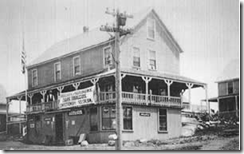 "I can't change it but Fortune will" and the young sailor, into whose hands the trader's wife had slipped the bag of coin, opened it, thus displaying his supposed wealth and made such an impression on Mother Harmon that all objections were removed and Peggy Harmon became not long after Mrs. Francis For-tune. Thus the property came into the Fortune family and the place has been Fortunes Rocks ever since.
"I can't change it but Fortune will" and the young sailor, into whose hands the trader's wife had slipped the bag of coin, opened it, thus displaying his supposed wealth and made such an impression on Mother Harmon that all objections were removed and Peggy Harmon became not long after Mrs. Francis For-tune. Thus the property came into the Fortune family and the place has been Fortunes Rocks ever since.
For many years there was an impression that the name was Fortin originally, but nowhere in any deed or conveyance does that spelling appear, it being always Fortune and so the name of the place stands.
There is a legal conveyance dated Oct. 17, 1843, from Francis Fortune to John G. Benson and signed by Peggy Fortune in release of her dower rights. In 1848, John G. Benson conveyed the premises in such a way as to secure to Francis and Peggy Fortune "a good, comfortable and sufficient support during their natural lives".
Later the property passed by sale through a number of owners, William Curtis and his son, John, at first. In 1872, John Curtis sold to Warren C. Bryant property "the same being known as the Francis Fortune Place, containing 20 acres more or less," excepting two parcels of land owned by some Dayton people.
The above disposes of the question of the early owners of the tract of land lying between the Lily Pond, the land of John Thomas, the Peter Pond and the sea.
Mr. Bryant readily sold lots of land to parties desiring to erect cottages for summer homes. The first house was built by Mr. I. D. Hooper in 1874 on the lot now occupied by Cove Cottage, owned by Mr. E. E. Blake. The Hooper cottage was a small, primitive affair, queerly arranged, having two front doors side by side, but only one kitchen and one stairway. The Hoopers were an elderly couple and sold the lot and cottage in the early 801s. A small cottage owned by Zebulon Staples of Lyman, or some neighboring town, stood on the site occupied by the large home now owned by the Centers.
Very early in his real estate operations Mr. Bryant became owner of a small house on Jefferson Street, occupied by Tim Mooney a well known porter at the old Biddeford House. One very snowy winter Bryant moved the Mooney house down the Pool road and to the 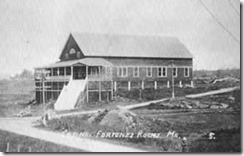 Rocks. The journey on sleds took some time and there was no need of hurry. Occasionally, in the local newspapers would appear an item headed "shipping news" and reading something like this: "Spoken off the pump-Sloop Mooney, Capt. W. C. Bryant -all well on board." The little house finally arrived and was moored on the high knoll on the right of the road, near where the Webster cottage now stands and was for rent at a very laic price. We young people sometimes engaged it for ten days or two weeks and with some efficient chaperone in charge spent a pleasant vacation within its hospitable walls.
Rocks. The journey on sleds took some time and there was no need of hurry. Occasionally, in the local newspapers would appear an item headed "shipping news" and reading something like this: "Spoken off the pump-Sloop Mooney, Capt. W. C. Bryant -all well on board." The little house finally arrived and was moored on the high knoll on the right of the road, near where the Webster cottage now stands and was for rent at a very laic price. We young people sometimes engaged it for ten days or two weeks and with some efficient chaperone in charge spent a pleasant vacation within its hospitable walls.
In 1876, Mr. Bryant, Judge Abel Jelleson, Hon. Ferguson Haines, the Berry brothers and E. W. Wedgewood built summer cottages and later Harmony Cottage, the property of Benjamin Wedger, manufacturer of fireworks in Boston, was erected. Other owners were Messrs. Woodbury and Taylor, Mrs. Broune, Dr. C. J. 1nery and the Chadbournes.
The old bowling alley, which stood on the low land close to the Lily Pond was moved there from the Ferry by W. C. Bryant and formed a real community center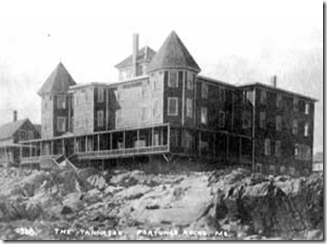 for the cottagers, where dancing parties, musical and dramatic entertainments were often produced. Russell B. Walker of Boston, a famous old-time dancing master, then retired, owned a small but very comfortable cottage near the Berry house and he and his accomplished wife were often in charge of the dancing parties, which were conducted with dignity and decorum on such occasions. There was much musical talent among the cottagers; everyone did his or her share in adding to the general pleasure and anything like rivalry or jealousy was unknown, old and young giving of their time and talent without stint.
for the cottagers, where dancing parties, musical and dramatic entertainments were often produced. Russell B. Walker of Boston, a famous old-time dancing master, then retired, owned a small but very comfortable cottage near the Berry house and he and his accomplished wife were often in charge of the dancing parties, which were conducted with dignity and decorum on such occasions. There was much musical talent among the cottagers; everyone did his or her share in adding to the general pleasure and anything like rivalry or jealousy was unknown, old and young giving of their time and talent without stint.
Religious services were begun at an early date, praise and prayer meetings being given in different homes and the bowling alley, arranged by either Mr. James G. Garland or Mrs. Abel Jelleson. Later on, a regular service on Sunday was held at Curtis Farm, then as now a popular summer hotel or boarding house. It was here that the first collection was taken toward raising a fund for the building of "St. Philips-by-the Sea," which was begun in 1905, consecrated in 1909 and where the Rev. Philip Schuyler holds service on Sunday ' afternoons during the summer season.
This little church contains memorial windows and other memorials, gifts of interested friends. The altar was given by Mr. Harry P. Garland of Saco and Mrs. Wm. F. Etherington of New York City, in memory of their father, the late James G. Garland, whose little cottage called by many "A Day's Rest," stood on the spot now occupied by the "Boulders, 't the property of Mr. and Mrs. Wm, F. Etherington.
The beautiful and symbolical "Lych-Gate," which marks the entrance to the walk, leading to the church, giving an old world touch to the premises, was erected in memory of Mr. Wm. H. Hopkins, in 1920.
In the old days of the eighties and nineties Mr. and Mrs. Ferguson Haines dispensed a gracious and in her case a graceful hospitality from their cottage on the cliff, now owned by Mr. Woodside, who has made many improvements in this and the other houses owned by him and has done so much to beautify the little village.
Mrs. Abel Jelleson was a veritable mother-in-Israel to all the residents and very much beloved by everyone. Mrs. Benjamin Wedger, always a great favorite with old and young, is now living at the age of 96, and a little snapshot picture of her, taken a few years since, showed the same smile and sweet expression that made her face seem. like a benediction. 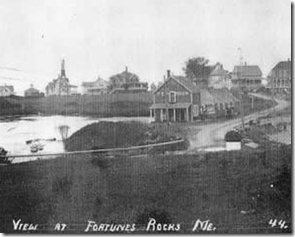 The Berry home with its generations of whole-souled, hospitable people was a center for many years and the list could be continued indefinitely. The present Casino was first erected in 1908. Last spring many improvements were made through Mr. S. G. Etherington, whose public-spirited generosity is a household word and whose constant additions to the pleasures and comforts of his neighbors at Fortunes Rocks are boundless. It is needless to dwell on them for the present day resident sees and knows all about the many good deeds and the numerous kindnesses and courtesies that emanate from "The Knoll," the Etherington summer home. Boats, bridges, bath houses and tennis courts are among the many things constantly in use and enjoyed by the young people.
The Berry home with its generations of whole-souled, hospitable people was a center for many years and the list could be continued indefinitely. The present Casino was first erected in 1908. Last spring many improvements were made through Mr. S. G. Etherington, whose public-spirited generosity is a household word and whose constant additions to the pleasures and comforts of his neighbors at Fortunes Rocks are boundless. It is needless to dwell on them for the present day resident sees and knows all about the many good deeds and the numerous kindnesses and courtesies that emanate from "The Knoll," the Etherington summer home. Boats, bridges, bath houses and tennis courts are among the many things constantly in use and enjoyed by the young people.
To return to earlier and more primitive times, the space at the end of the bowling alley now filled with reeds and rushes was covered with the shallow waters of the Lily Pond nearly to the side of the road and there was what an old-timer the other day called the Community Wash House, a shed equipped with tubs, wash boards and wringers, where any of the women might bring bundles 'of laundry work and where busy housewives met and acted "the Madonna of the Tubs" on many a Monday.
The water was very warm and soft and all one needed was a bar of soap and a determined spirit and the new song of the shirt could be heard many times and oft as the mothers scrubbed and the children played about.
Life was a simple thing in those days and we turned our work into play as much as possible. Plenty of fish, fresh from the sea, clams and lobsters ad libitum-a grocery delivery wagon once a week and meat "once-in-so-often;" vegetables, berries, butter, eggs and poultry from neighboring farms and we lived well and sumptuously.
In mentioning some of the homes, I omitted to tell of the admiration expressed when the house on the amin road, with the tower front and rooms above and below alm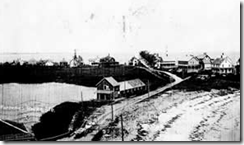 ost entirely devoted to windows was built by Mr. Henry Bacon of Lowell, a native and former resident of Biddeford. It was the first home with any attempt at architecture or adornment; all the others being of a strictly utilitarian design. This home was greatly admired and shown to visitors until it became familiar to all the residents, and still stands looking about the same as it did 35 years ago and more as it is still Bacon property and well kept up.
ost entirely devoted to windows was built by Mr. Henry Bacon of Lowell, a native and former resident of Biddeford. It was the first home with any attempt at architecture or adornment; all the others being of a strictly utilitarian design. This home was greatly admired and shown to visitors until it became familiar to all the residents, and still stands looking about the same as it did 35 years ago and more as it is still Bacon property and well kept up.
The colony has grown, many new cottages have sprung up, there are new faces seen at church and at Casino gatherings; the young people have a wonderful time and old ocean, the rocks, the splendid beach and the expanse of sky, with fresh water ponds and woodlands for a background are as beautiful as every they were.
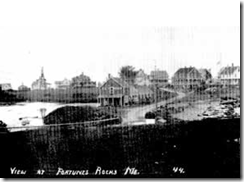 There are two hotels, Curtis Farm, now "Tanner's" and "Hotel Rox," built and managed by Louville Emmons, who has been identified with Fortunes Rocks for many years.
There are two hotels, Curtis Farm, now "Tanner's" and "Hotel Rox," built and managed by Louville Emmons, who has been identified with Fortunes Rocks for many years.
Electric lights, water works, telephones, radios, and the ever present motor cars have transformed the life of the place, as it has everywhere else and if Francis and Peggy Fortune could come back and walk along the old "King's Highway" can we even faintly picture what would be their feeling and sensations.
